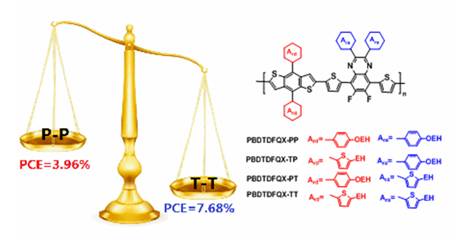Donor-Acceptor alternating copolymers with low band gaps have attracted an increasing amount of attention in the research community because the photovoltaic devices fabricated based on them show high power conversion efficiencies (PCEs) with both high open-circle voltage and high short-circuit current. Generally, the photovoltaic performance is mainly determined by the backbone structures of polymers. However, with the development of studies on side-chain engineering, side chains were also found to have a great impact on the photovoltaic performance. Current studies on side chains are mainly restricted to “mono-modification of side chains” that focuses on the influence of side chains attached to either donor or acceptor unit,neglecting the interaction between the neighboring units, while studies on side chains attached to both donor and acceptor unit are relatively rare. Recently, a research group from Key Laboratory of Carbon Fiber and Functional Polymers, Ministry of Education, Beijing University of Chemical Technology systematically studied the synergic effect of side chains attached to neighboring units by modifying side chains attached to both donor and acceptor unit. Related research has been published on Journal of Materials Chemistry A.

The research group studied the effect of different sets of side chains on the photovoltaic performance of materials by designing and synthesizing four PBDT-DFQx copolymers based on BDT as donor unit and Qx as acceptor unit of the main chains with p-alkoxyphenyl or 2-alkylthienyl as conjugated side chains attached to both donor and acceptor unit. The results showed strong interaction between neighboring side chains. The size and electronic property of side chains have great impacts on the physical and chemical properties of materials. Among them, the polymer with two 2-alkylthienyl as side chains showed the broadest light absorption, the lowest bandgap, and the highest charge carrier mobility, resulting in the highest PCE of 7.68%.
1W1A-Diffuse X-ray Scattering Station of BSRF was used to measure the microstructure of the PBDT-DFQx: PC71BM=1:1(w/w) blend films. The results indicated that all the polymer backbones preferentially stacked out of the film plane (edge-on rich orientation) and strong interaction existed between the polymers and PC71BM. The interaction inhibited the self-assembly of the fullerene and induced the aggregation of the polymers. The polymers with thienyl as conjugated side chains showed the closest π-π stacking and the shortest stacking distance, which corresponded well with the fact that the polymer PBDT-DFQX-TT with two thienyl as side chains showed the highest charge transfer ability and the highest PCE of the photovoltaic device.
The main contributor of this research, Prof. Haiqiao Wang from College of Materials Science and Engineering, Beijing University of Chemical Technology, stated, “The effect of side chains on the photovoltaic performance of devices is intricate. Apart from the chemical structure of the side chains that affects the photophysical and photochemical properties of the materials, the micro-environment where the side chains locate in also affects the condensed structure of the materials. Therefore, when optimizing polymers by side-chain engineering, one must consider every aspect of the factors so as to achieve high performance photovoltaic polymers. BSRF provides a strong technical support for our further study on the influence of side chains.”
Article:
Meng Wang, Di Ma, Keli Shi, Shaowei Shi, Song Chen, Changjiang Huang, Zi Qiao, Zhi-Guo Zhang, Yongfang Li, * Xiaoyu Li * and Haiqiao Wang * The Role of Conjugated Side Chains in High Performance Photovoltaic Polymers.Journal of Materials Chemistry A 3(2015),2802-2814.


